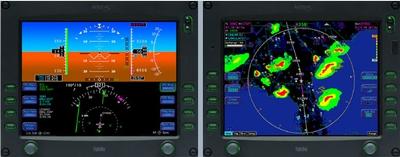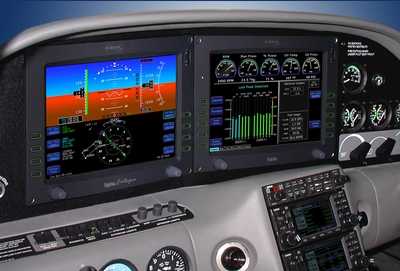Sat, Nov 01, 2003
More than 1,200 people packed Thursday morning's general session
at AOPA Expo to hear several leaders in the avionics industry talk
about the revolution in the cockpit that has occurred over the past
five years.

Mark Sandeen of Avidyne, Gary Kelley of Garmin, and Dan Barks of
Honeywell joined AOPA President Phil Boyer on stage, while
representatives from a number of other companies were also on hand.
Boyer began by pointing out that AOPA is the only aviation
association, GA or otherwise, to have a staff member assigned
full-time to advanced and emerging technologies. Senior Director of
Advanced Technologies Randy Kenagy has been tracking and
shepherding many of the technologies just now becoming available
for as long as the past five to seven years.
All three representatives on stage stressed the safety and
reliability of the new integrated flight decks that have become
available this year. "Total situational awareness is affordable for
everyone," said Avidyne's Sandeen. "The integrated flight decks
help solve situational awareness problems," echoed Garmin's Kelley.
"'What angle is the controller bringing me in on? Is he bringing me
in right over the outer marker?' The new displays help keep the
pilot informed."

During the question-and-answer period, Boyer asked Kelley about
Garmin's acquisition of UPS Aviation Technologies. Kelley assured
Boyer and the audience that Garmin has succeeded by developing new
technologies and driving the price down as low as possible. He said
that buying out one competitor is not going to change that business
model.
One member, noting that he could not use the FAA's Traffic
Information System (TIS) because there was no Mode S datalink
capability in his area, asked if there were any plans to provide
TIS via satellite. Garmin's Kelley responded that he was not aware
of any plans to do so. Kelley said that once ADS-B (automatic
dependent surveillance-broadcast) is widely available, it would be
a better solution. ADS-B-equipped aircraft broadcast a highly
accurate GPS-derived position to other ADS-B-equipped aircraft and
through ground stations to air traffic controllers.
The FAA has been testing ADS-B technology in Alaska's Capstone
project for a number of years. AOPA has been actively and
intimately involved in those tests. FAA Administrator Marion Blakey
acknowledged AOPA's participation during her address at yesterday's
General Session, presenting Boyer with a plaque honoring AOPA for
its role.

"AOPA believes strongly in the value of ADS-B and other cockpit
datalink technologies," said Boyer. "We believe the new
technologies offer such tremendous benefits that pilots will
voluntarily spend money to upgrade. But we will continue to fight
to make sure that the cost of the upgrade does not become the price
of a ticket to use the National Airspace System."
More News
“While legendary World War II aircraft such as the Corsair and P-51 Mustang still were widely flown at the start of the Korean War in 1950, a new age of jets rapidly came to >[...]
Decision Altitude (DA) A specified altitude (mean sea level (MSL)) on an instrument approach procedure (ILS, GLS, vertically guided RNAV) at which the pilot must decide whether to >[...]
Aero Linx: National Aviation Safety Foundation (NASF) The National Aviation Safety Foundation is a support group whose objective is to enhance aviation safety through educational p>[...]
Also: Cal Poly Aviation Club, $$un Country, Arkansas Aviation Academy, Teamsters Local 2118 In response to two recent general aviation accidents that made national headlines, more >[...]
“The FAA is tasked with ensuring our skies are safe, and they do a great job at it, but there is something about the system that is holding up the medical process. Obviously,>[...]
 Aero-News: Quote of the Day (04.28.25)
Aero-News: Quote of the Day (04.28.25) ANN's Daily Aero-Term (04.28.25): Decision Altitude (DA)
ANN's Daily Aero-Term (04.28.25): Decision Altitude (DA) ANN's Daily Aero-Linx (04.28.25)
ANN's Daily Aero-Linx (04.28.25) Airborne-Flight Training 04.24.25: GA Refocused, Seminole/Epic, WestJet v TFWP
Airborne-Flight Training 04.24.25: GA Refocused, Seminole/Epic, WestJet v TFWP Aero-News: Quote of the Day (04.29.25)
Aero-News: Quote of the Day (04.29.25)





